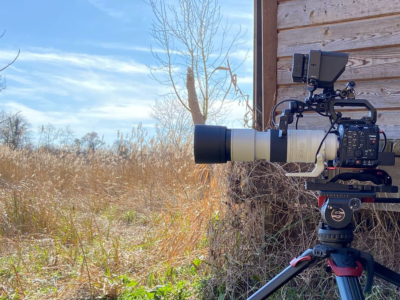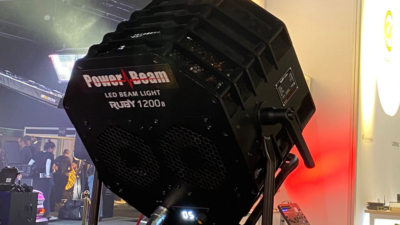
Cette 29ème édition du festival a été l’occasion de nombreuses mises en avant du travail collaboratif entre les chefs décorateurs et les directeurs de la photographie dans la construction visuelle de l’univers du film. Un travail colossal qui vise à créer un monde riche qui accompagne émotionnellement les enjeux du film.
Cet article propose une synthèse et une réflexion nourrie par deux conférences présentées à Camerimage : “Creating Worlds on Screen : Production Design and Cinematography” et “Rosco Seminar : How to build a World, Cinematography and Production Design on The Colony”
A la recherche du lieu idéal
Chaque projet est unique et redéfinit ses propres règles en matière de préparation. La genèse se crée selon les besoins de l’histoire et les relations entre les différentes personnes impliquées dans cette construction. Mais ce qui apparaît comme universel dans ces travaux préparatoires, c’est l’échange des visions et des expertises de chacun au profit de la mise en place d’un univers crédible et émotionnel.
Kalina Ivanov, Cheffe décoratrice de « The Tender Bar » de George Clooney, partage son expérience sur ce film qui nous plonge dans la vie du journaliste J. R. Moehringer et sa quête d’une figure paternelle. Pour elle, il était essentiel de raconter l’histoire d’une famille à travers les murs de sa maison. Elle souhaitait qu’ils portent les marques des années passées. En nous exposant ses recherches et ses planches de travail, elle nous plonge dans un univers déjà très détaillé et donne vie à chacun des décors qu’elle construit. Ce travail est effectué en étroite collaboration avec le directeur de la photographie Martin Ruhe et le réalisateur, car elle construit ses décors pour servir la caméra. Il ne s’agit pas de créer le décor le plus beau ou exceptionnel qu’il soit, mais bien de le mettre en place autour du propos et des choix cinématographiques.
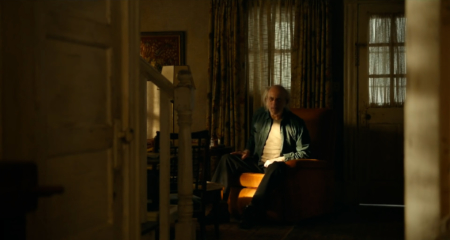
The Tender Bar ©Amazon Prime Video
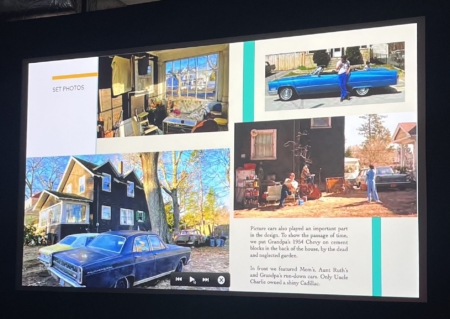
Les éléments proposés par la cheffe décoratrice de « The Tender Bar » s’alignent avec les histoires des personnages du film
Directrice de la photographie sur le film de Jane Campion « The Power of the Dog », Ari Wegner ACS exprime le même avis sur le travail du chef décorateur Grant Major. La maison du film est construite en fonction des angles de prise de vue, afin de renforcer l’émotion par l’espace. La mise en scène s’appuie alors sur ses décors pour contrôler et influencer la capacité des personnages à se mouvoir. Mais dans ce western crépusculaire, le caractère infini des espaces sauvages est au cœur de la mise en scène. Avec une place aussi importante accordée aux décors il fallait que l’équipe du film se pose cette question essentielle : “Où voulons nous que le film prenne place ?”. A travers cette interrogation à priori classique, il s’agit en réalité de trouver l’âme du décor dans le monde réel, puis de construire l’univers du film autour de celui-ci. Ils entreprennent donc un voyage de “plusieurs jours, plusieurs semaines […] pour trouver le meilleur endroit pour créer ce monde et bâtir la maison sur ces terres”
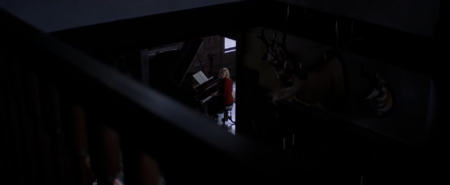
The Power of the Dog ©Netflix
Créer un monde, ce n’est pas seulement une recherche de lieu ou de décors parfaits, c’est aussi et surtout penser à “ce qui fait l’identité de ce monde.” En abordant cette question, Nelson Coates, chef décorateur du film de John M Chu, « In the Heights », nous amène à réfléchir sur l’histoire du lieu où prendra place l’action du film. Ici, un quartier de New York. Plus spécifiquement, le film se déroule autour d’une boutique à l’angle de deux rues. Il était très important pour eux que ce décor principal soit le lieu de convergence de tous les espaces du film. L’espace de cette comédie musicale est alors cartographié autour de cette intersection vers laquelle mènent les chorégraphies. C’est donc naturellement ce décor qui est le premier à être trouvé. Mais le chef décorateur insiste sur la nécessité de se plonger profondément dans l’histoire du quartier afin de recréer un univers crédible et riche. Pour lui, “vous trouvez votre film à travers les repérages. C’est un voyage à la recherche de votre monde”. Les détails du monde réel deviennent des éléments narratifs puissants. Il se souvient du clignotement incessant des lumières défectueuses du métro qu’il a pris dans le quartier lors d’une de ces journées de repérage. Cette lumière inconstante, ils décident, avec la directrice de la photographie Alice Brooks ASC, d’en faire un élément important dans l’identité visuelle d’une scène de rêve de l’un des personnages. Se laisser nourrir par les irrégularités du réel pour renforcer les marqueurs émotionnels de l’intrigue semble primordial dans la construction d’un univers puissant.
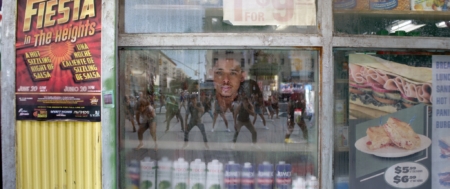
In The Heights ©Warner Bros.
Parfois le directeur de la photographie intervient en amont du chef décorateur dans cette recherche du lieu du film. C’est le cas de Markus Förderer ASC BVK qui nous explique qu’il est le premier à être intervenu sur le film « The Colony » car il avait auparavant collaboré avec le réalisateur Tim Fehlbaum sur son film « Hell ». Ils effectuent ensemble de nombreux tests, filmés sur le décor naturel de la mer allemande des Wadden qui s’impose comme le décor idéal dans la représentation d’un monde post-apocalyptique. Mais rendre ce décor spectaculaire implique un tournage entre chien et loup, et le limiterait à quatre heures par jour, ce qui est économiquement inenvisageable. C’est ainsi que Julian Wagner, chef décorateur, se voit confier la mission complexe de recréer ce décor en studio. Les plans d’ensemble et plans larges peuvent alors être tournés en décor naturel afin de rendre sensible l’immensité de ce désert de sable et d’eau, tandis que les plans rapprochés sont mis en place en studio par le biais d’une combinaison ingénieuse entre éléments naturels et technologie Softdrop de Rosco.
Adapter le décor aux besoins du film : “The Tender Bar” le décor comme personnage
Il est essentiel d’adapter le lieu choisi aux besoins du film et de l’histoire, il est donc souvent nécessaire de le reconstruire pour que les possibilités de tournage ne se retrouvent pas restreintes au seul espace réel du lieu. Le bar et la maison de l’oncle de J. R. Moehringer de “The Tender Bar” sont ainsi reconstitués et adaptés en studio. Avec un intérieur 10 fois plus grand que la taille originelle, le décor permet alors de faciliter les déplacements de la caméra et de connecter les espaces entre eux afin d’y opérer des mouvements d’appareil plus narratifs et plus sensibles. Kalina Ivanov donne l’illusion de hauteur d’un décor situé à l’étage d’une maison par exemple en faisant construire ce décor sur une plateforme. Il s’agit de recréer un espace en phase avec la mise en scène et l’impression qu’elle doit faire ressentir au spectateur.
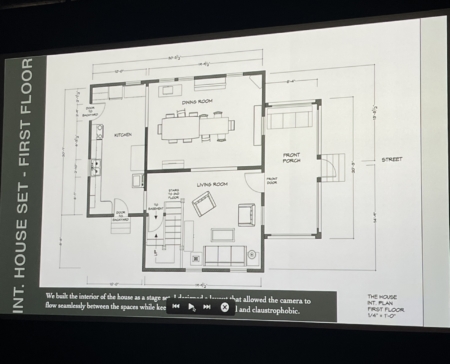
Le concept du premier étage de la maison par Kalina Ivanov
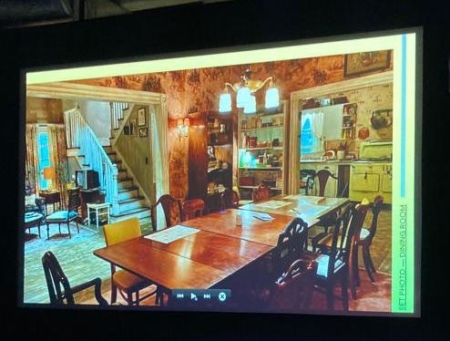
Photo du set final construit
La reconstruction en studio permet également d’adapter les espaces techniques nécessaires à l’installation de la machinerie et de l’éclairage. Ici tous les plafonds sont amovibles, facilitant ainsi l’installation des lumières de jeu ou des praticables pour les projecteurs. Cela offre une liberté de création presque infinie, au service de l’intrigue et des enjeux narratifs du film. L’objectif de la cheffe décoratrice est de créer des décors qui caractérisent les personnages qui les habitent. Ils servent de marqueur temporel à l’histoire et permettent de guider le spectateur à travers l’évolution des protagonistes. Ceux-ci grandissent, vieillissent, mais les décors traversent le temps et sont marqués par les souvenirs de ce qu’ils étaient. C’est l’immense travail de recherche en amont sur les couleurs, les textures, les motifs qui ornent les murs qui permet concrètement à l’idée du décor de prendre vie. Kalina estime qu’il “faut toujours aller plus profondément dans la matière pour que la caméra la retranscrive de manière juste et sensible. Mais toujours en s’arrêtant avant que l’effet ne soit visible et ne deviennent du théâtre ». La lumière sur un décor par exemple, peut exister bien avant que le directeur de la photographie n‘intervienne. C’est pourquoi elle aime échanger en amont sur les couleurs et les formes des lumières de jeu qu’affectionnent les directeurs de la photographie avec qui elle collabore. “Il est important que chacun soit ouvert aux idées de l’autre”.
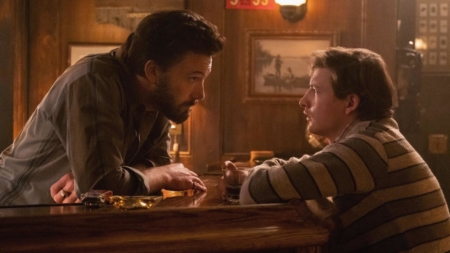
« The Tender Bar » ©Amazon Prime Video
Le monde sur scène, transformer le plateau en piste de danse : “In the Heights”
Réussir la mise en place d’une comédie musicale à l’écran implique de créer un espace pensé autour des chorégraphies et de la manière dont elles seront tournées. Cela détermine entièrement la construction du plateau qui devra être adaptable afin d’accompagner le mouvement de la danse par le décor. Pour préparer “In the Heights”, l’équipe cartographie chaque chanson et construit un langage commun à tous les départements techniques en déterminant quel sera le rôle de chacun dans la création de l’univers du film. Il s’agit alors de coordonner leurs expertises pour construire un monde hybride entre décor physique, cinématographie et effets visuels.
Lorsque cela est possible, l’équipe tourne les plans extérieurs directement dans les rues qu’ils ont choisies. Ils adaptent l’environnement de ces rues en construisant de nouvelles façades ou en modifiant certains détails afin de créer le reste de leur monde au sein du monde réel. Nelson Coates explique qu’il y a parfois un aspect légal à respecter lorsque l’on tourne dans des lieux existants. C’est notamment le cas d’un mur de briques couvert d’un graffiti qu’ils doivent recouvrir car les droits de cette œuvre appartiennent au street artist qui l’a réalisée. Mais l’idée de conserver un graffiti sur ce mur semblant être l’idéal pour coller à l’environnement naturel de leur décor, ils décident de concevoir leur propre œuvre en lui donnant un aspect symbolique en lien avec l’histoire.
Malheureusement, les intérieurs de la boutique ne permettent pas à une équipe de tournage d’y opérer. Dans ce cas, il est donc indispensable de reconstruire entièrement ce décor intérieur afin d’y projeter l’âme du film. Mais alors l’une des questions essentielles dans cette chorégraphie des espaces est “comment effacer la rupture entre les intérieurs et les extérieurs ?”. Pour cela il faut créer des connexions entre ces deux mondes et parfois il est nécessaire de reconstruire en partie les extérieurs en studio. Ainsi il sera possible de naviguer d’un décor intérieur à un décor extérieur en un même plan et de lier ces deux espaces par la mise en scène. Dans ce but, une partie de l’intersection de “In the Heights” est reconstituée par l’équipe, ce qui nécessite un travail de raccord lumière extrêmement précis de la part de la directrice de la photographie Alice Brooks ASC.
Mais le gros challenge de ce film est une séquence aux allures oniriques entre deux protagonistes qui débutent une danse sur des escaliers new yorkais pour finir flottants sur les murs d’un immeuble et défiants toute gravité. Cet effet irréel est rendu possible par la construction d’une plateforme semblable à la façade du bâtiment dans un studio fond vert, qui permettra l’ajout d’effets visuels en post-production. Le détail ingénieux est qu’une partie de cette plateforme est mécanisée afin de s’élever à 90°. C’est donc par un jeu de lumière, de mouvement de caméra et de mécanisme du décor que l’impression volatile est donnée. Afin de parvenir à un résultat crédible et fort émotionnellement, il s’agit de mettre en place dès la préparation, et ce jusqu’à la finalisation de la scène, un dialogue précis entre construction d’un décor, direction de la photographie et VFX.
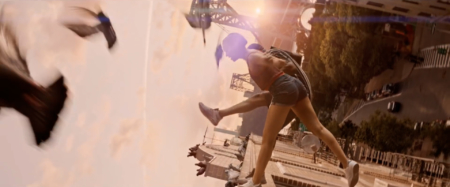
Le résultat final: In The Heights ©Warner Bros.
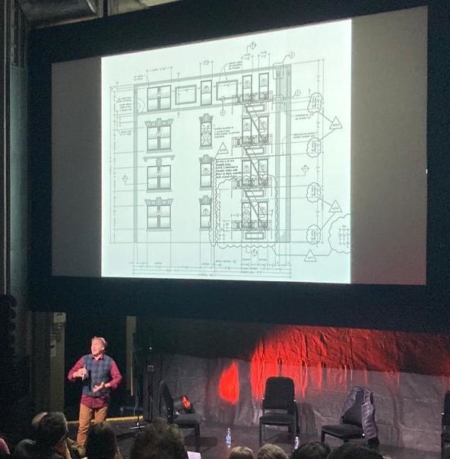
Nelson Coates présente son concept de façade dynamique qui s’abaisse de 90 à 0 degrés en 5 Secondes
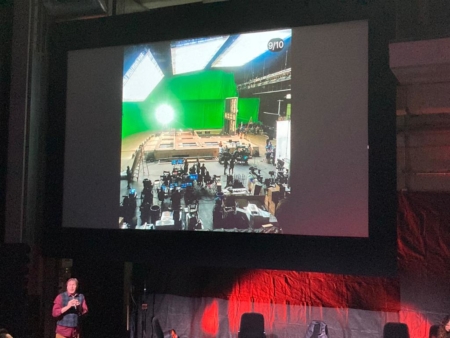
Quand le mécanisme de la façade se déclenche, la caméra, les lumières, les comédiens, et le paysage VFX doivent suivre le même mouvement, créant ainsi une séquence au laps de temps impressionnant. Dans ce type de mise en place, il est d’une importance primordiale que les acteurs soient sécurisés à des câbles par le département qui gère les cascades. Il revient à l’équipe des VFX de créer le fond qui remplacera le fond vert. Ils doivent donc coordonner le changement dynamique du paysage et du soleil au mouvement de la camera et de la façade. Alice Brooks et ses équipes lumière et machinerie conçoivent l’installation de trois grandes ‘softboxes’ au plafond pour simuler la lumière ambiante du ciel, ainsi qu’une source tungstène puissante pour créer le soleil en studio. Cette source est installée sur une grande grue sur Dolly afin de lui faire effectuer un mouvement complexe et crédible qui accompagne le mouvement de la façade dynamique. L’ intensité et la colorimétrie des ‘softboxes’ sont programmées pour évoluer dans ce lapse de temps et pour s’accorder avec le changement dynamique du fond. Cette orchestration précise entre les départements permet un résultat remarquable qui crée l’un de ces moments importants où le cinéma devient de la magie.
Élargir les horizons : “The Power of the Dog” et Focus sur “The Colony”, ou comment retrouver l’immensité de la mer
Cette question du lien entre les extérieurs et les intérieurs et de déterminer ce qui est visible dans les arrières plans, Ari Wegner ACS et Grant Major y consacrent une grande partie de leur travail sur le film de Jane Campion. Pour des questions de budget, il leur est indispensable d’éviter que chaque plan se déroulant dans un décor intérieur avec une découverte devienne un plan à VFX. Mais ils souhaitent également ne pas être contraints par l’utilisation de rideaux qui réduisent considérablement l’espace du film aux simples intérieurs. Ils aspirent à ce que l’immensité de l’espace naturel extérieur se ressente à travers les fenêtres et les portes des décors. Ils s’orientent donc vers la conception de ‘backdrops’ que le chef décorateur avait déjà eu l’occasion d’utiliser sur ses précédents projets. L’intrigue s’étendant sur plusieurs saisons, ils conçoivent des toiles de fond pour chacune des périodes, à différents moments de la journée, afin de faire évoluer l’environnement autour de leur décor au rythme du film.
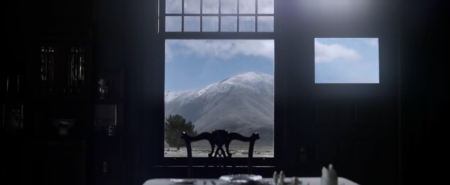
The Power of the Dog ©Netflix
C’est cette même technologie qu’utilise l’équipe de “The Colony” pour rendre crédibles ses paysages marins reconstitués en studio. Pour cela, il leur est indispensable de penser le décor de manière hybride. Premièrement, celui-ci est organisé autour d’une immense plateforme sur laquelle est reconstituée la plage, construite dans les Bavaria Studios ( considérés comme les plus grands d’Europe). Ce sol est le résultat de recherches poussées sur les textures du sable et de l’eau, mais également sur l’interaction entre ces deux éléments naturels. Car c’est la réflexion du ciel dans les flaques créées au sol qui donne toute la puissance au décor. Il semble évident à Markus Förderer et Julian Wagner que l’utilisation des Softdrops de Rosco est la meilleure alternative aux fonds pour tourner le film de manière plus authentique et sensitive, car contrairement à un plateau fond vert, ce type de procédé permet l’utilisation d’une gamme plus large de matériaux dans les décors et les costumes. Les effets de transparence et de réflexion, particulièrement complexes à maîtriser sur un fond vert, redeviennent possibles du fait même du caractère organique de ce type de plateau. Ce dernier point participe également à plonger l’ensemble de l’équipe au cœur d’une expérience plus immersive et donc bien plus tangible.
La plateforme se trouve donc entourée d’un fond de 9m de haut sur 90m de longueur, créé à partir de plates 8K du décor originel qui sont fusionnées pour recréer l’immensité du ciel de la mer des Wadden. Afin de faire varier l’arrière-plan des différentes séquences tournées sur ce même fond, ils élaborent une technique qui leur permet d’avoir un premier effet de ciel imprimé à l’avant et un second imprimé à l’arrière. Ainsi, en adaptant l’éclairage en front et en back, il devient possible de créer une série plus large d’ambiances lumineuses sur le même décor. Durant la préparation du film, Markus effectue une série de tests sur des décors miniatures pour déterminer les différentes techniques d’éclairage qu’ils devront mettre en place sur le tournage pour que cette technique soit un succès.
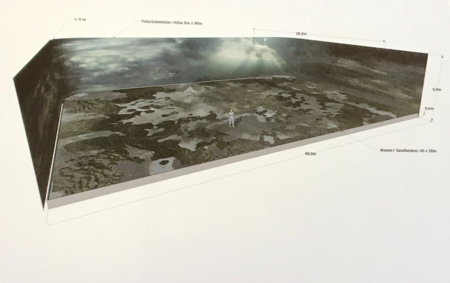
Représentation 3D du plateau de The Colony ©Julian Wagner – Markus Förderer – Berghaus Woebke Filmproduktion

Maquette du plateau de The Colony ©Julian Wagner – Markus Förderer – Berghaus Woebke Filmproduktion
D’après ces recherches et accompagné par son gaffeur Uwe Greiner, le directeur de la photographie conçoit l’installation d’une centaine de Skypanels, placés au sol derrière le Softdrop, afin de créer cette impression de lumière émanant de l’horizon propre aux couchers et levers de soleil. A cela s’ajoute une ligne de projecteurs ETC à l’avant du fond ainsi qu’un skysoft homogène pour relever le niveau sur l’action qui se déroule sur la plateforme. Tous les projecteurs étant programmables, la variation de l’éclairage entre chaque séquence est extrêmement simple et adaptée à la fois aux scènes de nuit et aux scènes de jour. Cela leur fait gagner un temps précieux. Pour certaines séquences, ils ajoutent à ce principe de base un ARRIMAX 18kg en backlight, derrière le Softdrop pour simuler les rayons du soleil qui percent à travers les nuages.
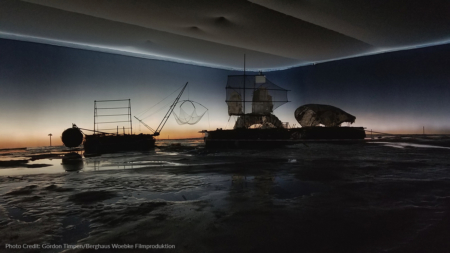
Plateau de The Colony ©Gordon Timpen – Berghaus Woebke Filmproduktion
Ainsi cet assemblage ingénieux reconstitue de manière crédible l’environnement du film. Mais il reste un élément essentiel à la sensation de réalité dans ce décor. En effet, le rendu de l’espace et de son immensité en condition naturelle est un véritable enjeu pour que la reconstitution en studio ne semble pas limitée. Pour parfaire l’illusion, la difficulté est de réussir à recréer une ligne d’horizon plus éloignée qu’elle ne l’ai vraiment. Une ligne fluide entre le ciel et la terre où se confond l’infini. Tout cela est rendu possible par l’utilisation contrôlée d’un élément essentiel : la fumée. La mise en place de plusieurs machines à brouillard sur le plateau, au-delà de créer une atmosphère propice à l’intrigue, permet de lier l’ensemble et de renforcer la sensation d’immensité. Le résultat est une image où il devient alors difficile de percevoir la démarcation entre la plateforme et le Softdrop, évitant ainsi de ressentir l’espace réduit d’un studio.
Compte tenu du budget réduit du film, le travail effectué est impressionnant et démontre l’importance d’une coopération entre les différents chefs de départements afin de trouver la solution adéquate aux défis du film. Ces différentes expériences permettent de transformer un plateau en un univers tangible et complexe.

Comparatif entre décor naturel et reconstitution en studio, The Colony ©Berghaus Woebke Filmproduktion
Ouvrir le champ des possibles grâce aux VFX
La bonne réflexion entre ces différentes expertises répond à des volontés artistiques propres à chaque film, mais est également garante d’une maîtrise des coûts indispensable pour mener à bien un projet. Pour autant, il est parfois indispensable d’élargir l’univers du film grâce aux possibilités qu’offre le travail des VFX. Sans parler des décors intégralement créés en post-production, qui représentent un autre type de travail et de techniques, il faut s’intéresser à comment les ajouts numériques viennent « élargir le réel”.
Cette coordination entre décors réels et effets visuels est également le fruit d’une collaboration étroite entre l’équipe de tournage et l’équipe des VFX qui implique souvent la présence du superviseur des effets spéciaux sur le tournage. D’après Kalina Ivanov, “le chef décorateur recrée physiquement le monde du film, puis les VFX viennent finaliser l’idée de ce monde”. C’est ici que le “langage commun” sur lequel insiste Nelson Coates devient essentiel. Les intervenants partagent tous le même avis sur la question : ce langage doit être mis en place dès la conception des dessins préparatoires élaborés par le chef décorateur. En effet, il y a à ce moment du processus, une réflexion sur le partage du travail entre chaque département dans l’élaboration des éléments visuels : d’un côté les éléments qui doivent être construits et pensés pour le réel – “Dans quelle mesure devons nous construire ce monde physiquement ?”, et de l’autre les éléments qui seront traités en post-production. Tous ces éléments doivent être coordonnés de manière précise afin de rendre crédible l’univers du film.
Filmographie
“The Tender Bar”
Réalisateur : George Clooney
Directeur de la photographie : Martin Ruhe ASC
Cheffe décoratrice : Kalina Ivanov
“In The Heights”
Réalisateur : Jon M. Chu
Directrice de la photographie : Alice Brooks ASC
Chef décorateur : Nelson Coates
“The Power of the Dog”
Réalisatrice : Jane Campion
Directrice de la photographie : Ari Wegner ACS
Chef décorateur : Grant Major
“The Colony”
Réalisateur : Tim Fehlbaum
Directeur de la photographie : Markus Förderer ASC BVK
Chef décorateur : Julian Wagner
_ _ _ _
ENGLISH VERSION
_ _ _ _
This 29th edition of the festival was the occasion to highlight the collaborative work between the production designers and the cinematographers in the construction of the world of the film. A considerable work that aims to create a rich universe that emotionally supports the stakes of the film.
This article offers a synthesis and a reflection based on two conferences presented at Camerimage: « Creating Worlds on Screen: Production Design and Cinematography » and « Rosco Seminar: How to build a World, Cinematography and Production Design on The Colony ».
The Search for the Perfect Place
Each project is unique and redefines its own rules in terms of preparation. The genesis is created according to the needs of the story and the relationships between the different people involved in this construction. But what appears to be universal in this preparatory work is the exchange of visions and expertise of each person in order to create a credible and emotional world.
Kalina Ivanov, the production designer of George Clooney’s « The Tender Bar », shares her experience on this movie that immerses us in the life of journalist J. R. Moehringer and his search for a father figure. For her, it was essential to tell the story of a family through the walls of their home. She wanted them to bear the marks of the past years. By exposing her research and her worksheets, she takes us into a very detailed universe and gives life to each of the sets she builds. This work is done in close collaboration with the cinematographer Martin Ruhe ASC and the director because she builds her sets to serve the camera. It is not a question of creating the most beautiful or exceptional set, but rather of setting it up around the subject and the cinematographic choices.

The Tender Bar ©Amazon Prime Video

The elements proposed by the designer of « The Tender Bar » fit with the stories of the characters in the film
The cinematographer on Jane Campion’s « The Power of the Dog », Ari Wegner ACS expresses the same opinion on the work of the production designer Grant Major. The house in the movie is built according to the shooting angles, in order to increase the emotion through the space. The direction then relies on its sets to control and influence the characters’ ability to move. But in this twilight western, the endlessness of the wilderness is at the heart of the direction. With such an important place given to the locations, the film crew had to ask themselves this essential question: « Where do we want the movie to take place? Through this classical question, they had to find the soul of the set in the real world, and then build the universe of the movie around it. So they start a journey of « several days, several weeks […] to find the best place to create this world and build the house on this land »

The Power of the Dog ©Netflix
Creating a world is not just a search for the perfect location or setting, it’s also, and more importantly, thinking about « what makes that world authentic. » In addressing this question, Nelson Coates, production designer of John M Chu’s film, « In the Heights », leads us to think about the history of the place where the action of the movie will take place. Here, a New York City neighborhood. More particularly, the film takes place around a store on the corner of two streets. It was very important to them that this main setting will be the place of convergence of all the spaces in the movie. The space of this musical is then mapped around this intersection towards which the choreographies lead. It is therefore natural that this set is the first to be found. But the production designer insists on the need to dive deeply into the history of the neighborhood in order to recreate a credible and rich universe. For him, « you find your film through location scouting. It’s a journey to find your world. The details of the real world become powerful narrative elements. He remembers the incessant flickering of the faulty subway lights he took in the neighborhood on one of those location scouting days. This fickle light, they decide, with cinematographer Alice Brooks ASC, to make it an important element in the visual identity of a dream scene of one of the characters. Letting the irregularities of reality feed into the emotional markers of the plot seems essential in building a powerful universe.

In The Heights ©Warner Bros.
Sometimes the cinematographer is involved before the production designer in this search for the film’s location. This is the case of Markus Förderer ASC BVK who explains that he was the first to work on the movie « The Colony » because he had previously collaborated with the director Tim Fehlbaum on his movie « Hell ». Together they did a lot of test shooting on the natural setting of the German Wadden Sea, which is the ideal setting for the representation of a post-apocalyptic world. But making this setting spectacular would mean shooting during the magic hour and would limit it to four hours a day, which was economically unrealistic. So Julian Wagner, production designer, was given the complex task of recreating this setting in a studio. The wide shots could be shot on location in order to capture the immensity of this sand and water desert, while the close-up shots were set up in the studio using an ingenious combination of natural elements and Rosco’s Softdrop technology.
Adapting the set to the needs of the movie: « The Tender Bar » the set design as a character
It is essential to adapt the chosen location to the needs of the movie and the story, so it is often necessary to rebuild it so the shooting possibilities are not limited to the real space of the location. The bar and the house of J. R. Moehringer’s uncle in « The Tender Bar » are reconstructed and adapted in a studio. With an interior 10 times larger than the original size, the set allows the camera to move around more easily and to connect the spaces between them in order to make the camera moves more narrative and more expressive. For example, Kalina Ivanov gives the illusion of height to a set located on the floor of a house by having this set built on a platform. It is a matter of recreating a space in phase with the direction and the impression that the spectator should feel.
The concept of the first floor of the house by Kalina Ivanov:

Concept of the second floor of the house by Kalina Ivanov

Photography of the final set built
The rebuilding in the studio also allows adapting the technical spaces necessary to the installation of the machinery and the lighting. Here, all the ceilings are removable, facilitating the installation of the practical lights or the projectors. This offers almost infinite freedom of creation, at the service of the plot and the narrative stakes of the movie. The goal of the set designer is to create sets that define the characters who inhabit them. They serve as a temporal marker for the story and help guide the audience through the evolution of the protagonists. They grow up, age, but the sets go through time and are marked by the memories of what they were. It is the immense amount of research done beforehand on the colors, textures, and patterns that adorn the walls that allows the set to come to life. Kalina believes that « you always have to go deeper into the material so that the camera can transcribe it in an accurate and sensitive way. But always stopping before the effect is noticeable and becomes theatrical ». The light on a set, for example, can exist long before the cinematographer arrives. That’s why she likes to talk upfront about the colors and shapes of the practical lights « It’s important that everyone is open to each other’s ideas. »

« The Tender Bar » ©Amazon Prime Video
The world on stage, turning the stage into a dance floor: « In the Heights »
Successfully putting a musical on screen involves creating a space thought around the choreography and how it will be shot. This fully determines the construction of the set, which will have to be adaptable in order to follow the movement of the dance through the set design. To prepare « In the Heights », the crew maps out each song and builds a common language for all the technical departments by determining what role each will play in creating the film’s universe. They then coordinate their expertise to build a hybrid world between the physical set, cinematography and visual effects.
Whenever possible, the team shoots exterior shots directly on the streets they have chosen. They adapt the environment of these streets by building new facades or changing details to create the rest of their world within the real world. Nelson Coates explains that sometimes there is a legal aspect to shooting in real locations. For example, they have to cover up a brick wall with graffiti because the rights belong to the street artist who did it. But the idea of keeping a graffiti on this wall seemed to be the ideal to stick to the natural environment of their set, they decided to design their own artwork by giving it a symbolic aspect in connection with the story.
Unfortunately, the store’s interiors do not allow a film crew to operate there. In this case, it is therefore essential to completely rebuild the interior set design in order to preserve the soul of the film. But then one of the essential questions in this choreography of spaces is « how to erase the gap between the interior and the exterior? To do this, it is important to create connections between these two worlds and sometimes it is needed to partially reconstruct the exteriors in the studio. In this way, it will be possible to navigate from an interior to an exterior setting in the same shot and to link these two spaces through the staging. For this purpose, part of the intersection of « In the Heights » is reconstructed by the crew, which requires an extremely precise work of light connection from the cinematographer Alice Brooks ASC.
But the big challenge of the movie is a dreamlike sequence between two protagonists who start to dance on New York stairs and end up floating on the walls of a building, defying gravity. This surreal effect becomes possible through the construction of a platform similar to the building’s facade in a green screen studio, which will allow the addition of visual effects in post-production. The ingenious detail is that a part of this platform is mechanized in such a way that it can be raised at 90°. It is therefore through a play of light, camera movement, and mechanism of the set that the airy impression is given. In order to achieve a credible and emotionally strong result, a precise dialogue between the construction of the set, the cinematography and VFX must be established from the preparation to the finalization of the scene.

Final result: In The Heights ©Warner Bros.

Nelson Coates presents his dynamic facade concept that lowers from 90 to 0 degrees in 5 Seconds

When the facade mechanism is triggered, the camera, lights, actors, and VFX environment must follow the same movement, creating an impressive time-lapse sequence. In this kind of setup, it is of primary importance that the actors are secured to cables by the stunt department. The VFX team is responsible for creating the background that will replace the green screen. They must match the dynamic change of the landscape and the sun to the movement of the camera and the facade. Alice Brooks and her lighting and machinery teams designed the installation of three large softboxes on the ceiling to simulate ambient skylight, as well as a powerful tungsten source to create the sun in the studio. This source is mounted on a large crane on Dolly to make it perform a complex and credible movement that accompanies the movement of the dynamic facade. The intensity and colorimetry of the softboxes are programmed to evolve in this time-lapse and to match the dynamic change of the background. This precise orchestration between departments allows for a remarkable result that creates one of those important moments where cinema becomes magic.
Expanding horizons: « The Power of the Dog » and Focus on « The Colony », or how to recover the immensity of the sea
Ari Wegner ACS and Grant Major devoted a large part of their work on Jane Campion’s film to the question of how to link exteriors and interiors and to determine what is visible in the background. For budgetary reasons, it is essential that they avoid having every shot that takes place in an interior setting with a view become a VFX shot. But they also wanted to avoid being restricted by the use of curtains, which significantly reduced the film’s space to simple interiors. They desire the immensity of the natural space outside to be felt through the windows and doors of the sets. They, therefore, turned to the design of ‘backdrops’ that the set designer had already used on his previous projects. As the plot spans several seasons, they designed backdrops for each period, at different times of the day, in order to make the environment around their set evolve with the rhythm of the movie.

The Power of the Dog ©Netflix
This is the same technology that the crew of « The Colony » uses to make its seascapes believable, although they are reconstituted in the studio. For this, it is essential to conceive the set in a hybrid way. First, it is organized around a huge platform on which the beach is recreated, built in the Bavaria Studios (considered the largest in Europe). This floor is the result of intensive research on the textures of sand and water, but also on the interaction between these two natural elements. It is the reflection of the sky in the puddles created on the ground that gives the setting its power. It is clear to Markus Förderer and Julian Wagner that the use of Rosco Softdrops is the best alternative to backgrounds to shoot the movie in a more authentic and sensitive way because unlike a green screen set, this type of process allows the use of a wider range of materials in the production designs and costumes. The effects of transparency and reflection, particularly complex to master on a green screen, become possible again because of the organic character of this type of set. This last point also contributes to plunging the whole team into the heart of a more immersive and thus much more tangible experience.
The platform is surrounded by a 9m high and 90m long background, created from 8K plates of the original set that are combined to recreate the immensity of the Wadden Sea sky. In order to vary the background of the different sequences shot on this same backdrop, they develop a technique that allows them to have a first sky effect printed on the front and a second printed on the back. Thus, by adapting the front and back lighting, it becomes possible to create a wider range of lighting moods on the same set. During the preparation of the movie, Markus did a series of tests on miniature sets to determine the different lighting techniques they would need to implement on the set to make this technique a success.

3D representation of the set of The Colony ©Julian Wagner – Markus Förderer – Berghaus Woebke Filmproduktion

Model of the set of The Colony ©Julian Wagner – Markus Förderer – Berghaus Woebke Filmproduktion
Based on this research and assisted by his gaffer Uwe Greiner, the cinematographer conceived the installation of a hundred Skypanels, placed on the ground behind the Softdrop, in order to create this impression of light coming from the horizon, specific to sunsets and sunrises. In addition, there is a line of ETC projectors at the front of the background and a uniform Skysoft to raise the level on the platform. Since all the lights are programmable, the variation of the lighting between each sequence is extremely simple and adapted to both night and daylight scenes. This saves them a lot of time. For some scenes, they add to this basic principle an ARRIMAX 18kg backlight, behind the Softdrop to simulate the sun’s rays breaking through the clouds.

The Colony set ©Gordon Timpen – Berghaus Woebke Filmproduktion
In this way, this ingenious combination reconstitutes the environment of the movie in a believable way. But it remains an essential element to the feeling of reality in this setting. Indeed, the rendering of the space and its vastness in natural conditions is a real challenge so the reconstitution in the studio does not seem limited. To achieve the illusion, the difficulty is to succeed in recreating a horizon line further away than it really is. A fluid line between the sky and the earth where the infinite merges. All this is accomplished through the controlled use of an essential element: smoke. The installation of several fog machines on set, beyond creating an atmosphere conducive to the plot, allows to link the whole and to reinforce the feeling of immensity. The result is an image where it becomes difficult to perceive the demarcation between the platform and the Softdrop, avoiding the feeling of a reduced studio space.
Considering the small budget of the film, the work done is impressive and demonstrates the importance of cooperation between the different department heads in order to find the right solution to the challenges of the film. These different experiences help to turn a set design into a tangible and complex universe.

Comparison between natural setting and studio reconstruction, The Colony ©Berghaus Woebke Filmproduktion
Opening the field of possibilities through VFX
The good collaboration between these different experts answers to the artistic needs, specific to each movie, but is also a guarantee of control of the costs essential to carry out a project. However, it is sometimes essential to expand the film’s universe through the possibilities offered by VFX work. Without talking about the sets entirely created in post-production, which represent another type of work and techniques, it is necessary to be interested in how the digital additions come « to enlarge the reality ».
This coordination between real sets and visual effects is also the result of a close collaboration between the film crew and the VFX team, which often involves the presence of the VFX supervisor on the set. According to Kalina Ivanov, « the set designer physically recreates the world of the movie, and then VFX comes to finalize the idea of this world ». This is where the « common language » that Nelson Coates insists on becomes essential. The speakers all share the same opinion on the question: this language must be established from the conception of the preparatory drawings elaborated by the set designer. Indeed, at this point in the process, there is a reflection on the work-sharing between each department in the elaboration of visual elements: on the one hand, the elements that must be built and thought for the real world – « how much do we have to build this world physically? », and on the other hand, the elements that will be processed in post-production. All these elements must be coordinated in a precise way in order to make the world of the movie believable.
Filmography
“The Tender Bar”
Director : George Clooney
Cinematographer : Martin Ruhe ASC
Production designer : Kalina Ivanov
“In The Heights”
Director : Jon M. Chu
Cinematographer : Alice Brooks ASC
Production designer : Nelson Coates
“The Power of the Dog”
Director : Jane Campion
Cinematographer : Ari Wegner ACS
Production designer : Grant Major
“The Colony”
Director : Tim Fehlbaum
Cinematographer : Markus Förderer ASC BVK
Production designer : Julian Wagner
-
Partager l'article
